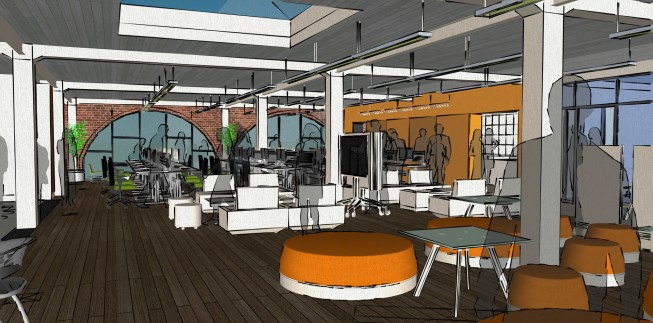This is the first article in a four-part series offering strategies for future-proofing your architectural practice.
During the Great Recession, many early career architects, either by choice or by force, found themselves on their own, starting small firms and sole proprietorships to eke it out until the economy rebounded. Oscia Wilson, AIA, was one of them, running a small firm operating out of Chicago and San Francisco focused on tenant improvement build-outs. Though she made it work, she had trouble shaking the inevitable downsides—insufficient work facilities and limited client pools among them—of a small-scale operation. “It’s hard to start up any kind of legitimate business that attracts legitimate clients when you’re working out of your kitchen,” she says.
Wilson realized that her firm could benefit by partnering up and sharing space with other small firms. But for her plan to work, it had to be more than a simple co-working arrangement and more akin to a small firm co-operative committed to sharing as many resources as possible.
Her idea grew, and after a successful Kickstarter campaign earlier this year, she’s expecting to open BIG Oakland next year. The fully stocked design office, in Oakland, Calif., will be occupied by multiple independent professionals and firms up to six people, all in the AEC industry, which will have access to design software, a materials library, plotters, and a spacious studio.
These residents, who currently work in various home offices and conventional co-working spaces, will form one of the first design-specific co-working communities in the country. Wilson says the idea is as much about sharing space and resources as it is about having access to other design professionals who may become future collaborators. “You can compete with larger firms because you have the resources of a larger firm without having to pay them to be on your staff all the time,” she says.

BIG Oakland
Conceptual sketch for BIG Oakland
This model of sharing space, design tools, and work is relatively new for architects, who are typically competitive. But it can help small firms establish a professional presence and tap into extra resources when needed. And it may also be a way for smaller firms and sole proprietors to organically expand and contract along with the market’s fluctuations.
Architect Kevan Lynd, a sole proprietor in Culver City, Calif., has been sharing office space with other architects for more than a decade. He has found the arrangement good for sharing resources, like software know-how, and for engendering creative discussions that can benefit design projects. It’s also been good for business. “We had our own firms [and] our own projects, but we would help each other on different projects when it made sense,” he says. “It’s built-in labor. There’s definitely a synergy there.”
Having access to employees on-demand has allowed Lynd to diversify the type of work he pursues. “I can go for bigger projects than I might [by] myself because I can have more staff and more expertise,” he says. He recently pursued a golf-club remodeling project with help from his officemates’ knowledge of the hospitality market. “The fact that we have varied expertise in the office gives us a little more flexibility,” he says.
Jean Leathers, president of Cleveland-based architecture business consultancy Practice Clarity, notes that resource sharing can also be thought of as a form of resiliency planning: Architects don’t necessarily have to share spaces with each other full-time, but they should consider developing sharing agreements with like-minded firms in case of economic or natural disasters.
“Any firm that’s in a seismic, hurricane, or tornado zone should have some kind of risk-management [agreement],” she says. For architects wary of partnering with the competition, Leathers suggests forming an alliance with a trusted professional collaborator, such as an engineering firm. “You say, ‘Hey, if something goes wrong in your building, if a disruption occurs, you can set up shop here, and we’ll have the same understanding as you.’ ”
In 1989, after a 6.9-magnitude earthquake struck the San Francisco Bay Area, sharing arrangements were made on the fly. The San Francisco offices of the Architectural Resources Group (ARG) weren’t heavily affected, so they opened their doors to fellow architects to use their space. Because the San Francisco–Oakland Bay Bridge was shut down, the office’s location on Pier 9 made it a readily accessible site for those commuting across the bay by ferry. ARG founding principal Stephen Farneth, FAIA, says making room for others was a natural response. “Everybody was just busy trying to help everyone else,” he says.
Preparing for such disasters before they happen is key. Leathers recommends putting such agreements in writing—including what resources or personnel will be shared, the duration of the sharing period, and prohibitions against poaching workers—to mitigate the potential for additional problems.
Given the inherent turbulence of the market and the long list of things that can potentially go wrong at any time, architects may find that sharing resources is a worthwhile form of protection.
Note: This story has been updated since first publication.
